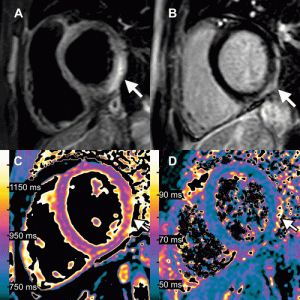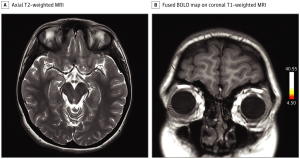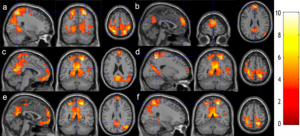A healthy 15-year-old boy received his second dose of the Pfizer-BioNTech COVID-19 vaccine. The next day, he developed fever, myalgia, and intermittent tachycardia. At presentation to the hospital, electro-cardiography showed ST-segment elevation in the left precordial leads. High-sensitive cardiac troponin and C-reactive protein levels were elevated. Echocardiography showed normal myocardial function without wall motion abnormalities. Cardiac MRI showed a normal left ventricular size, a normal left ventricular ejection fraction, and a small pericardial effusion. T2-weighted short inversion time inversion recovery sequences displayed focal myocardial edema involving the lateral wall, most emphasized in the basal inferolateral segment (Figure, A). Corresponding subepicardial enhancement was detected with late gadolinium enhancement imaging indicating inflammatory necrosis (Figure, B). Quantitative myocardial mapping parameters were elevated, which confirmed the qualitatively assessed findings (Figure, C, D). Because of the close temporal relation between the COVID-19 vaccination and the onset of symptoms (1 day), vaccine-induced hypersensitivity myocarditis was the clinical diagnosis.
This case shows that clinicians should be aware of vaccine-induced myocarditis as a possible adverse effect in children with thoracic and/ or cardiovascular complaints after COVID-19 vaccination. As children are now scheduled to be vaccinated in many countries, cases of vaccine-induced myocarditis will have been noted in association with messenger RNA vaccines. Vaccine-associated myocarditis is rare but more common in the younger population, especially in males (eg, incidence of 40.6 cases per million second doses of COVID-19 vaccinations in males aged 12–29 years).
Reference: https://doi.org/10.1148/radiol.2021211766




